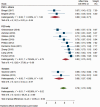Efficacy and safety of flow diverters in posterior circulation aneurysms and comparison with their efficacy in anterior circulation aneurysms: A systematic review and meta-analysis
- PMID: 33752478
- PMCID: PMC8493351
- DOI: 10.1177/15910199211003017
Efficacy and safety of flow diverters in posterior circulation aneurysms and comparison with their efficacy in anterior circulation aneurysms: A systematic review and meta-analysis
Abstract
Purpose: We aimed to assess the efficacy and safety of flow-diverter stents (FDs) in the management of posterior circulation cerebral aneurysms and compare FD efficacy between anterior and posterior circulation aneurysms.
Methods: We searched the PubMed, Scopus, Cochrane, and Web of Science databases for relevant studies through March 2020. Studies assessing FDs for posterior circulation aneurysms that included ≥20 treated aneurysms were included. Moreover, the studies compared FD efficacy between anterior and posterior circulation aneurysms were included. Data regarding angiographic aneurysmal occlusion, procedural complications, mortality, and morbidity were extracted and pooled in a random-effects meta-analysis model.
Results: Fourteen studies with a total of 659 patients and 676 posterior circulation aneurysms were included. The pooled rate of aneurysmal occlusion at long-term angiographic follow-up was 78% [95% confidence interval (CI), 71-85]. The pooled rates of intraparenchymal hemorrhage, ischemia, and procedure-related mortality and neurological morbidity were 2%, 8%, 7%, and 6%, respectively. Complete occlusion occurred in 82.4% of the posterior circulation aneurysm subgroup and 77.5% of the anterior circulation aneurysm subgroup. The difference was not significant (relative risk 1.01; 95% CI, 0.86-1.19; p = 0.91). Regression analysis showed that elderly patients and females had higher morbidity.
Conclusion: Posterior circulation aneurysms can be effectively treated with FDs with comparable occlusion rates to those in anterior circulation aneurysms. However, periprocedural complications are not negligible.
Keywords: Flow-diverter device; endovascular treatment; pipeline embolization device; posterior circulation aneurysms.
Conflict of interest statement
Figures













References
-
- Molyneux A, Kerr R, Stratton I, International Subarachnoid Aneurysm Trial (ISAT) Collaborative Group et al. International subarachnoid aneurysm trial (ISAT) of neurosurgical clipping versus endovascular coiling in 2143 patients with ruptured intracranial aneurysms: a randomised trial. Lancet 2002; 360: 1267–1274. - PubMed
-
- Rosenwasser RH, Chalouhi N, Tjoumakaris S, et al. Open vs endovascular approach to intracranial aneurysms. Neurosurgery 2014; 61: 121–129. - PubMed
-
- Gonzalez NR, Duckwiler G, Jahan R, et al. Challenges in the endovascular treatment of giant intracranial aneurysms. Neurosurgery 2008; 62: S3-113–S3-124. - PubMed
-
- Pistocchi S, Blanc R, Bartolini B, et al. Flow diverters at and beyond the level of the circle of Willis for the treatment of intracranial aneurysms. Stroke 2012; 43: 1032–1038. - PubMed
Publication types
MeSH terms
LinkOut - more resources
Full Text Sources
Other Literature Sources
Medical

